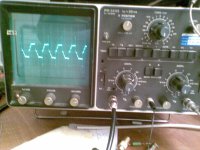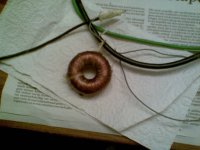On youtube I found this very interesting video showing how to use a scope to measure a cable: for instance for an open end.
Use a scope to measure the length and impedance of coax by w2aew.
The video explains very clearly how you can test a cable under its specific impedance. Misaligned - terminated with a wrong impedance - , there is overshoot. Terminated halfway, you get a bounce from the open not terminated end - and from that you can even measure the distance.
This sounds exotic - it is.
But I also remember that when testing input transformers I got the same step-response. Now I understand that the transformer was not loaded correctly, and not terminated at the end of the winding - hence the signal bounced and returned.
Use a scope to measure the length and impedance of coax by w2aew.
The video explains very clearly how you can test a cable under its specific impedance. Misaligned - terminated with a wrong impedance - , there is overshoot. Terminated halfway, you get a bounce from the open not terminated end - and from that you can even measure the distance.
This sounds exotic - it is.
But I also remember that when testing input transformers I got the same step-response. Now I understand that the transformer was not loaded correctly, and not terminated at the end of the winding - hence the signal bounced and returned.
When I get around it, I will retest a signal transformer to show the same step-wise response.
This definitely reduces ringing. I tried it myself. But is the hypothesis right?
albert
- Just as a hypothesis, is this then a bounce from the end of a unused coil - that is a not properly terminated winding?
This definitely reduces ringing. I tried it myself. But is the hypothesis right?
albert
Notice that they are measuring nanoseconds. Grace Hopper "the mother of COBOL," at her seminars, would hand out pieces of wire about 10 inches long. Explaining that an electric signal could travel the length of wire in a second. But she said that she was handing out 'nanoseconds'.
It takes a good high-speed scope to make that measurement.
It takes a good high-speed scope to make that measurement.
Yes I agree, have only a 10 Mhz scope. lowest res is 200 nS . .
Anyway: this is the signal I found on an input?? transformer.


See the same step-wise response of the rising and falling edge.
Is this due to wrong (too high) termination?
It shows a transformer that is terminated at 1000 ohms; it is a transformer that does +6,5 dB; primary 3,5 ohms, secondary 26 ohms. It can pass very high frequencies.
The video of measuring a cable in the first post reminded me of this strange transformer. Might it be a pulse transformer?
Anyway: this is the signal I found on an input?? transformer.


See the same step-wise response of the rising and falling edge.
Is this due to wrong (too high) termination?
It shows a transformer that is terminated at 1000 ohms; it is a transformer that does +6,5 dB; primary 3,5 ohms, secondary 26 ohms. It can pass very high frequencies.
- The lower Fc is 230 Hz terminated at 1000 and 400 ohm;
- When I terminate it at 100 ohms I have +7,5 dB with an Fc of 73 Hz
- dropping to 25 ohm I get 30 Hz but now gain drops to + 0,5 dB. Very good square wave.
- going down further improves the response to about 20 Hz and an upper bw of > 200 KHz. Still 1:1.
The video of measuring a cable in the first post reminded me of this strange transformer. Might it be a pulse transformer?
FYI -- The old TEK 7000 series oscilloscopes had a wide range of plug-ins available. One is a TDR. I use their model 7S12.
BTW - How does the loading of the transfomer affect the THD thru it or of the driving circuit to the transformer? Any affects there?
Thx-RNMarsh
BTW - How does the loading of the transfomer affect the THD thru it or of the driving circuit to the transformer? Any affects there?
Thx-RNMarsh
Last edited:
I now did the step-down configuration. So input on the 26 ohm as primary; output on the 3 ohms as secondary.
I also tested square wave in this step down; it exhibits quite some 'dirt' on the rising edge (still that bump half-way) ;
- I tested the THD, it is about 0,035% - not bad. (Radiometer Copenhagen)
Unloaded output. I have a pot that allows 10 ohm-45 ohms.
But i can't see the distortion itself as the level is too low; connecting the output of my distortionmeter creates [a ground loop] that spoils the input
The whole test setting only works above a certain level.
Input 2,7 V RMS from a fixed frequency pure sine generator of 2765 Hz.
Because the primary also drops when I lower the secondary load, I did not retest it; input drops to where the distortion meter thinks it is too low (below 300 mV in fact).
But i can't see the distortion itself as the level is too low; connecting the output of my distortionmeter creates [a ground loop] that spoils the input
The whole test setting only works above a certain level.
Input 2,7 V RMS from a fixed frequency pure sine generator of 2765 Hz.
Because the primary also drops when I lower the secondary load, I did not retest it; input drops to where the distortion meter thinks it is too low (below 300 mV in fact).
I also tested square wave in this step down; it exhibits quite some 'dirt' on the rising edge (still that bump half-way) ;
at 400 KHz there is a bump of +3 dB;there is a null (-20 dB) at 660 kHz; a bump of +4 at 1,167 Mhz; again one of +5 at 1,4 MHz;
the system looks so flat that even at 5 Mhz it is 0 dB;
the system looks so flat that even at 5 Mhz it is 0 dB;
Last edited:
- Status
- This old topic is closed. If you want to reopen this topic, contact a moderator using the "Report Post" button.
- Home
- Design & Build
- Equipment & Tools
- Testing a coax cable for open ends